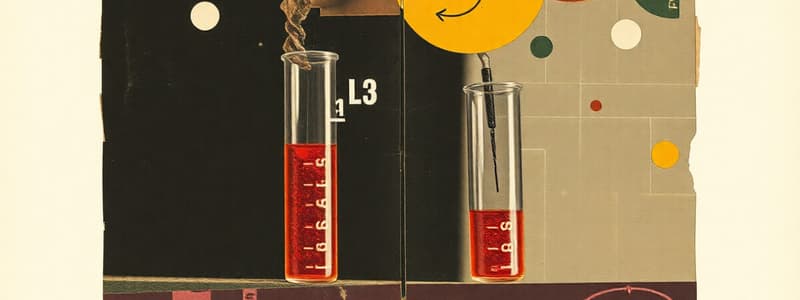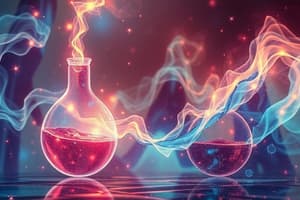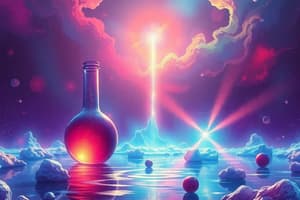Podcast
Questions and Answers
For the reversible reaction $aA + bB
ightleftharpoons cC + dD$, which expression correctly represents the equilibrium constant $K_c$?
For the reversible reaction $aA + bB ightleftharpoons cC + dD$, which expression correctly represents the equilibrium constant $K_c$?
- $K_c = \frac{[C]^c [D]^d}{[A]^a [B]^b}$ (correct)
- $K_c = \frac{[A][B]}{[C][D]}$
- $K_c = \frac{[C][D]}{[A][B]}$
- $K_c = \frac{[A]^a [B]^b}{[C]^c [D]^d}$
A catalyst affects the equilibrium constant of a reaction by shifting the equilibrium towards the products.
A catalyst affects the equilibrium constant of a reaction by shifting the equilibrium towards the products.
False (B)
State Le Chatelier's Principle.
State Le Chatelier's Principle.
If a system at equilibrium is subjected to a change in conditions, the system will adjust itself to counteract the change and restore a new equilibrium.
For an exothermic reaction, increasing the temperature will shift the equilibrium in the ______ direction.
For an exothermic reaction, increasing the temperature will shift the equilibrium in the ______ direction.
Match the equilibrium constant with its description:
Match the equilibrium constant with its description:
In the Haber process ($N_2(g) + 3H_2(g)
ightleftharpoons 2NH_3(g)$), which conditions favor the formation of ammonia ($NH_3$)?
In the Haber process ($N_2(g) + 3H_2(g) ightleftharpoons 2NH_3(g)$), which conditions favor the formation of ammonia ($NH_3$)?
For the reaction $2SO_2(g) + O_2(g)
ightleftharpoons 2SO_3(g)$, $\Delta n = -1$. If $K_c = 4.0$ at a certain temperature, what is the value of $K_p$ at the same temperature, assuming $R = 0.0821 L \cdot atm / (mol \cdot K)$ and $T = 300 K$?
For the reaction $2SO_2(g) + O_2(g) ightleftharpoons 2SO_3(g)$, $\Delta n = -1$. If $K_c = 4.0$ at a certain temperature, what is the value of $K_p$ at the same temperature, assuming $R = 0.0821 L \cdot atm / (mol \cdot K)$ and $T = 300 K$?
Consider the equilibrium: $H_2(g) + I_2(g)
ightleftharpoons 2HI(g)$. If the pressure on the system is increased, what will happen to the equilibrium?
Consider the equilibrium: $H_2(g) + I_2(g) ightleftharpoons 2HI(g)$. If the pressure on the system is increased, what will happen to the equilibrium?
Flashcards
Reversible Reaction
Reversible Reaction
Reactions proceeding in both forward and backward directions simultaneously.
Chemical Equilibrium
Chemical Equilibrium
State where the rate of forward reaction equals the rate of backward reaction.
Law of Mass Action
Law of Mass Action
It states that the rate of a chemical reaction is proportional to the product of the concentrations of the reactants
Equilibrium Constant (Kc)
Equilibrium Constant (Kc)
Signup and view all the flashcards
Equilibrium Constant (Kp)
Equilibrium Constant (Kp)
Signup and view all the flashcards
Kp and Kc Relationship
Kp and Kc Relationship
Signup and view all the flashcards
Le Chatelier’s Principle
Le Chatelier’s Principle
Signup and view all the flashcards
Effect of Catalyst
Effect of Catalyst
Signup and view all the flashcards
Study Notes
- Chemical reactions are either reversible or irreversible.
- Irreversible reactions proceed to completion, while reversible reactions occur in both directions, leading to equilibrium.
Dynamic Equilibrium
- At equilibrium, the rate of the forward reaction equals the rate of the backward reaction.
- Reactant and product concentrations remain constant, though not necessarily equal.
- Example reaction: (N_2 + 3H_2 \rightleftharpoons 2NH_3)
Law of Chemical Equilibrium
- For a reaction (aA + bB \rightleftharpoons cC + dD), the equilibrium constant (K_c) is: (K_c = \frac{[C]^c [D]^d}{[A]^a [B]^b})
- For gaseous reactions, the equilibrium constant (K_p) is: (K_p = \frac{P_C^c P_D^d}{P_A^a P_B^b})
- Relationship between (K_p) and (K_c): (K_p = K_c (RT)^{\Delta n})
Factors Affecting Equilibrium (Le Chatelier’s Principle)
- Le Chatelier’s Principle: A system at equilibrium, when disturbed, will shift to counteract the disturbance.
Effect of Concentration
- Increasing reactant concentration shifts the equilibrium forward.
- Increasing product concentration shifts the equilibrium backward.
Effect of Pressure (Gases)
- Increasing pressure shifts the equilibrium towards the side with fewer gas molecules.
- Decreasing pressure shifts the equilibrium towards the side with more gas molecules.
Effect of Temperature
- Exothermic reactions ((\Delta H < 0)): Increasing temperature shifts equilibrium backward.
- Endothermic reactions ((\Delta H > 0)): Increasing temperature shifts equilibrium forward.
Effect of Catalyst
- Catalysts do not affect equilibrium; they only speed up the rate at which equilibrium is reached.
Types of Equilibrium Constants
- (K_c): Concentration-based equilibrium constant.
- (K_p): Pressure-based equilibrium constant for gases.
- (K_w): Equilibrium constant for water dissociation ((1 \times 10^{-14}) at 25°C).
- (K_a) & (K_b): Acid and base dissociation constants.
- (K_{sp}): Solubility product constant for salts in solution.
Applications of Chemical Equilibrium
- Haber’s Process (NH₃ synthesis): High pressure and low temperature favor NH₃ formation.
- Contact Process (SO₃ formation for sulfuric acid production).
- Buffer solutions maintain constant pH in biological and chemical systems.
Important Formulas
- Equilibrium constant expression: (K_c = \frac{[products]}{[reactants]})
- (K_p = K_c (RT)^{\Delta n})
Studying That Suits You
Use AI to generate personalized quizzes and flashcards to suit your learning preferences.




